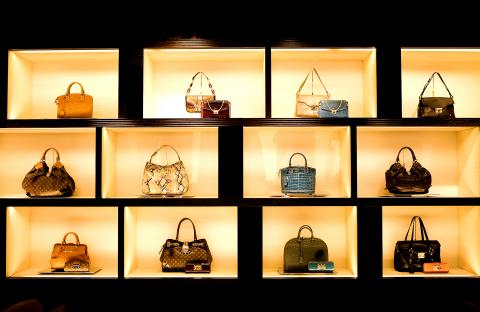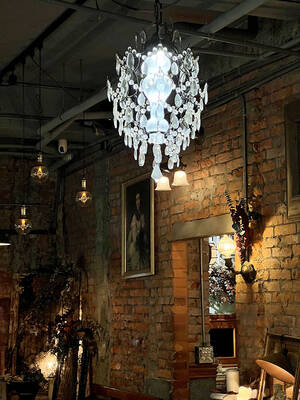Daisy Liu epitomizes China’s obsession with luxury brands: her shoes are Guiseppe Zanotti, her brooch Chanel, a floral Hermes scarf is stylishly knotted over one shoulder. She won’t, however, tote a monogrammed Louis Vuitton handbag ever again.
Wealthy shoppers like Liu are increasingly turning up their noses at labels they believe have been tainted by the common touch, seeking out understated, and exclusive, merchandise from the likes of Chanel or Hermes instead. That is becoming a big challenge for designers hoping to cash in on the world’s fastest growing luxury market.
“I have two Louis Vuitton handbags but I no longer carry them although they are still in fashion,” said Liu, a 31-year-old employee at a multinational cosmetics firm. “I don’t think the brand fits me any more.”

Photo: Bloomberg
More than a decade of strong economic growth has helped swell the disposable incomes of millions of Chinese, creating legions of men and women with a voracious appetite for status symbols regardless of the cost.
China’s importance for firms such as Louis Vuitton’s parent LVMH and Gucci’s PPR SA is indisputable: last year, as Europe was mired in financial crisis and the US economy faltered, Chinese shoppers spent an estimated US$18 billion on luxury goods, according to consultants Bain & Co.
China is the world’s third biggest market for personal luxury goods, worth at least US$25 billion. In the next three years, it is expected to leapfrog over Japan and the US to take the top spot, with the luxury segment expanding to US$28 billion.
As it grows, the market is also maturing, moving from so-called aspirational luxury, where bling is king, to what experts call absolute luxury: the desire to be seen as both wealthy and discerning.
“In the past, it was just a checklist. If you were one of the top five brands out of some magazine, you found that people in China just checked the checklist and bought according to the list,” said Vincent Liu, partner at Boston Consulting Group. “Going forward, people will be more selective. They know what and where and when to use what brands and products.”
For sophisticated consumers like Liu, that means purchases such as a US$2,000 Chanel mini bag and a Prada clutch. She’s also eyeing a coral lambskin bag from Bottega Veneta, the Italian fashion house renowned for its signature woven leather goods.
“The truly wealthy, the real millionaires, they will not want to buy LV Louis Vuitton or Gucci because they are too commonplace,” said Shaun Rein, managing director, China Market Research Group. “Rich people are getting richer and they want exclusiveness and more self-indulgence.”
OVER EXPOSED
China’s luxury market is poised to grow 18 to 20 percent this year, steeply outperforming the single-digit forecasts for Europe, the Americas and Japan, according to Bain, explaining the rapid expansion of larger luxury firms such as LVMH.
For years, LV’s Monogram “Speedy” tote, a dome-shaped classic favored by Audrey Hepburn, was one of the most desirable bags for Chinese women because it was a clear signal of having made it: the handbag costs double the US$400 an average Chinese worker earns a month.
The brand is LVMH’s cash cow and revenues are almost double those of Gucci, widely considered its closest competitor.
But as LVMH grew in China — there are currently about 38 Louis Vuitton stores there, including in remote areas such as the southern Guangxi autonomous region, compared to the 57 or so in Japan — it lost some of its cachet.
“In China, Louis Vuitton is seen as the brand that even your aiyi, or domestic helper, can afford,” said a retail consultant who declined to be named in order to be candid.
When asked to comment, LVMH told said it expected to “gain a brand new lead on the market” via a new store set to open next month in Shanghai’s swanky Plaza 66 mall. “The Plaza 66 will confirm Vuitton as the trendsetting brand in China,” the statement said.
Gucci did not immediately respond to requests for comment.
LV remains one of China’s most popular labels — a recent survey by strategists Digital Luxury Group put it at the top of web searches by consumers.
But brands such as Chanel and Hermes are catching up fast.
A recent study by consultants Bain shows twice as many Chinese now covet Hermes, creators of the iconic Birkin and Kelly handbags, and the brand is the third most likely to be purchased after Gucci and Louis Vuitton.
“Some prefer Hermes because our products are more subtle and not over exposed,” the brand’s China president, Leo Liu, said.
To attract shoppers, LVMH and other larger luxury brands are trying to strike the difficult balance between exclusivity and popularity to remain profitable.
LVMH is offering customers increasingly expensive and bespoke services to try to retain a mystique around the Louis Vuitton brand, whose creations are seen as being both too common and easily copied.
The company is also careful about rolling out new stores, aware that the brand would suffer from too much visibility.
Whether these strategies will convince savvy Chinese shoppers to carry their LV bags is unclear.

The Taipei Times last week reported that the rising share of seniors in the population is reshaping the nation’s housing markets. According to data from the Ministry of the Interior, about 850,000 residences were occupied by elderly people in the first quarter, including 655,000 that housed only one resident. H&B Realty chief researcher Jessica Hsu (徐佳馨), quoted in the article, said that there is rising demand for elderly-friendly housing, including units with elevators, barrier-free layouts and proximity to healthcare services. Hsu and others cited in the article highlighted the changing family residential dynamics, as children no longer live with parents,

The classic warmth of a good old-fashioned izakaya beckons you in, all cozy nooks and dark wood finishes, as tables order a third round and waiters sling tapas-sized bites and assorted — sometimes unidentifiable — skewered meats. But there’s a romantic hush about this Ximending (西門町) hotspot, with cocktails savored, plating elegant and never rushed and daters and diners lit by candlelight and chandelier. Each chair is mismatched and the assorted tables appear to be the fanciest picks from a nearby flea market. A naked sewing mannequin stands in a dimly lit corner, adorned with antique mirrors and draped foliage

The election of Cheng Li-wun (鄭麗文) as chair of the Chinese Nationalist Party (KMT) marked a triumphant return of pride in the “Chinese” in the party name. Cheng wants Taiwanese to be proud to call themselves Chinese again. The unambiguous winner was a return to the KMT ideology that formed in the early 2000s under then chairman Lien Chan (連戰) and president Ma Ying-jeou (馬英九) put into practice as far as he could, until ultimately thwarted by hundreds of thousands of protestors thronging the streets in what became known as the Sunflower movement in 2014. Cheng is an unambiguous Chinese ethnonationalist,

I was 10 when I read an article in the local paper about the Air Guitar World Championships, which take place every year in my home town of Oulu, Finland. My parents had helped out at the very first contest back in 1996 — my mum gave out fliers, my dad sorted the music. Since then, national championships have been held all across the world, with the winners assembling in Oulu every summer. At the time, I asked my parents if I could compete. At first they were hesitant; the event was in a bar, and there would be a lot